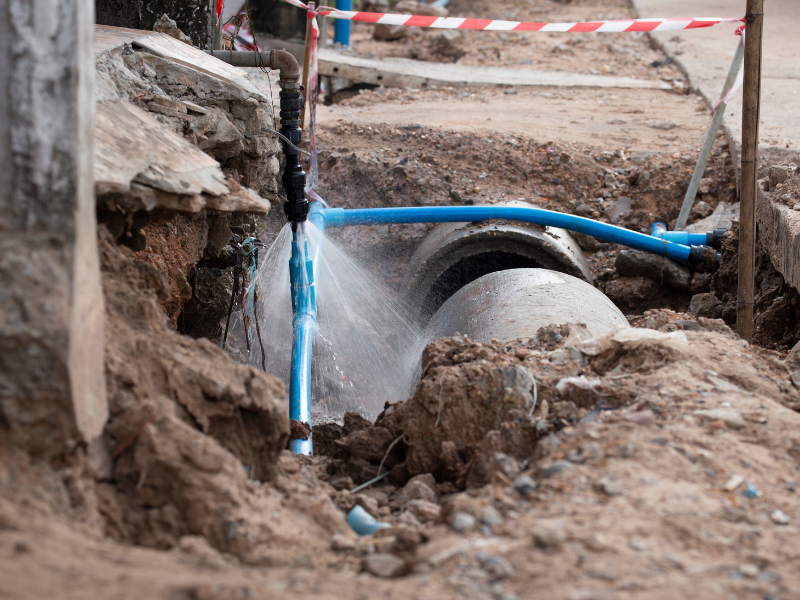Can a cracked clay sewer pipe be patched?
If you have a cracked clay sewer pipe, you may be wondering if it can be patched. Understanding the basics of clay sewer pipes is essential to determining the feasibility of patching. Clay sewer pipes have been used for many years and have proven to be durable and long-lasting. However, like any other material, they are not immune to cracks and damage over time. Identifying cracks in clay sewer pipes is crucial to addressing the issue promptly and preventing further damage to your plumbing system.
Understanding the Basics of Clay Sewer Pipes
Clay sewer pipes are made from a combination of clay, water, and shale mixtures that are molded and fired to create a strong and durable material. They have been widely used in sewer systems for their exceptional resistance to chemical deterioration and long lifespan. Clay pipes are popular due to their ability to withstand high temperatures, pressure, and corrosive substances commonly found in sewage. These pipes come in different sizes and shapes to accommodate the flow of wastewater from residential, commercial, and industrial buildings.
Clay sewer pipes have a fascinating history that dates back centuries. The use of clay pipes for sewage systems can be traced back to ancient civilizations, such as the Romans and Greeks. These early civilizations recognized the durability and reliability of clay as a material for transporting wastewater. The knowledge and techniques of clay pipe-making were passed down through generations, leading to the development of more advanced clay sewer pipes.
One of the remarkable qualities of clay sewer pipes is their resistance to chemical deterioration. The combination of clay, water, and shale mixtures creates a material that can withstand the harsh chemicals commonly found in sewage. This resistance to chemical corrosion ensures that clay pipes maintain their structural integrity over time, reducing the need for frequent repairs or replacements.
What are clay sewer pipes?
Clay sewer pipes are ceramic pipes that are used to transport wastewater from plumbing fixtures to the main sewer line. They are a common choice for both residential and commercial plumbing systems. These pipes are known for their strength, durability, and resistance to corrosion. Clay sewer pipes are typically installed underground and can last for several decades when properly maintained.
The manufacturing process of clay sewer pipes involves shaping the clay mixture into the desired size and shape. The molded pipes are then fired in a kiln at high temperatures, which strengthens the material and makes it more resistant to cracking or breaking. This firing process also gives the pipes their characteristic reddish-brown color.
Clay sewer pipes are available in various sizes and shapes to accommodate different plumbing needs. They can range from small pipes used in residential properties to large pipes used in industrial complexes. The size and shape of the pipes depend on the volume of wastewater that needs to be transported and the specific requirements of the plumbing system.
Why are clay sewer pipes used?
There are several reasons why clay sewer pipes are widely used in plumbing systems. First, clay pipes are highly resistant to chemicals, making them suitable for transporting corrosive fluids commonly found in sewage. This resistance to chemical corrosion ensures that the pipes remain intact and functional for extended periods.
Second, clay pipes have a smooth interior surface, which minimizes the buildup of debris. The smooth surface allows wastewater to flow freely without obstruction, reducing the chances of clogs and blockages. This feature is particularly beneficial in areas with high debris content, such as industrial zones or regions with heavy rainfall.
Third, clay sewer pipes are environmentally friendly. They are made from natural materials, such as clay and shale, which are abundant and sustainable. Additionally, clay pipes can be recycled after use, further reducing their environmental impact. The use of clay sewer pipes contributes to a more sustainable and eco-friendly plumbing infrastructure.
Finally, clay pipes have a long lifespan, meaning fewer replacements and reduced maintenance costs in the long run. When properly installed and maintained, clay sewer pipes can last for several decades without significant deterioration. This longevity makes them a cost-effective choice for sewer systems, saving both time and money on repairs and replacements.
In conclusion, clay sewer pipes are a reliable and durable choice for plumbing systems. Their resistance to chemicals, smooth interior surface, environmental friendliness, and long lifespan make them a popular option for transporting wastewater. Whether in residential, commercial, or industrial settings, clay sewer pipes continue to play a vital role in maintaining efficient and sustainable sewer systems.
Identifying Cracks in Clay Sewer Pipes
Cracks in clay sewer pipes can occur due to various factors, such as ground movement, tree root intrusion, or the aging of the pipes themselves. It is crucial to identify these cracks early to prevent further damage to your plumbing system and potential hazards to your property.
When it comes to ground movement, several factors can contribute to the pressure exerted on clay pipes. Changes in soil moisture content, freeze-thaw cycles, and even nearby construction activities can all play a role in causing the ground to shift and put stress on the pipes. This constant movement can eventually lead to cracks and fractures in the clay material.
Tree root intrusion is another significant cause of cracks in clay sewer pipes. As trees grow, their roots search for water and nutrients, often finding their way into the joints of the pipes. Over time, these roots can exert enough pressure to crack or collapse the clay pipes. It is essential to be mindful of the trees planted near your sewer lines and take preventative measures to minimize root intrusion.
Furthermore, natural wear and tear over time can weaken clay pipes, making them more prone to cracks and fractures. Factors such as the age of the pipes, exposure to harsh weather conditions, and the corrosive nature of certain substances in wastewater can all contribute to the deterioration of the clay material. Regular maintenance and inspections can help identify and address any potential issues before they escalate.
Signs and Symptoms of a Cracked Pipe
Several signs indicate you may have a cracked clay sewer pipe. First, if you notice sewage backups or slow drainage in your fixtures, it could be a sign of a cracked pipe. The cracks can impede the flow of wastewater, causing it to back up into your sinks, toilets, or showers. This can be both inconvenient and unsanitary, requiring immediate attention.
Foul odors coming from your drains are also indicators of a potential crack. When there is a crack in the sewer pipe, the foul-smelling gases from the sewage can escape into your home through the drains. These odors can be quite unpleasant and may worsen over time if the crack is not addressed.
In addition to indoor signs, there are also outdoor signs that can point to a cracked sewer pipe. Standing water in your yard, especially in specific areas, can be a result of a cracked sewage pipe leaking water into the soil. This excess moisture can create soggy patches and even lead to the growth of lush grass or vegetation. Paying attention to these changes in your yard can help you identify potential issues with your clay sewer pipes.
Overall, it is essential to be proactive in identifying and addressing cracks in clay sewer pipes. Regular inspections, prompt repairs, and preventative measures can help extend the lifespan of your plumbing system and prevent costly damage to your property.
The Feasibility of Patching a Cracked Clay Sewer Pipe
Once you have identified a crack in your clay sewer pipe, you may wonder if it can be patched. The feasibility of patching depends on several factors that need to be considered before deciding on the appropriate course of action.
Factors Influencing the Patching Possibility
One of the factors to consider is the size and location of the crack. Small cracks near the joints can often be successfully patched, while larger cracks or those located in the middle of the pipe may require more extensive repairs or even pipe replacement. The age and condition of the pipe are also important factors to consider. Older pipes that have suffered significant wear and tear may not be suitable candidates for patching. Finally, the overall condition of your plumbing system should be evaluated to determine if patching the cracked pipe will be a temporary fix or a long-term solution.
Risks Associated with Patching
It is essential to be aware of the risks associated with patching a cracked clay sewer pipe. Patching is not always a guaranteed solution, especially if the crack is extensive or if the pipe has multiple cracks. There is a risk of the patch failing over time, leading to further damage and potential sewage backups. Patching may also be costlier in the long run if the pipe continues to deteriorate and additional repairs or replacements are needed. It is crucial to consult with a professional plumber to assess the feasibility and risks of patching your specific cracked pipe.
Patching Techniques for Cracked Clay Sewer Pipes
There are various techniques available for patching cracked clay sewer pipes, ranging from traditional methods to modern innovations.
Traditional Patching Methods
One traditional method of patching a cracked clay sewer pipe is to use mortar or cement-based materials to seal the crack. This involves applying the patching material to the external surface of the pipe or filling the crack inside the pipe, depending on the accessibility and location of the crack. Another traditional method involves using specialized clay sleeves or collars to reinforce and stabilize the cracked section of the pipe.
Modern Patching Techniques
With advancements in technology, new patching techniques have emerged that offer more durable and long-lasting solutions. One modern technique is the use of epoxy resin. Epoxy resin can be applied to the inside of the cracked pipe, creating a strong, seamless, and watertight barrier. Another modern technique involves pipelining, where a new pipe is inserted into the existing cracked clay pipe, creating a smooth and structurally sound surface.
When to Consider Pipe Replacement Over Patching
While patching a cracked clay sewer pipe may be a viable option in some cases, there are situations where pipe replacement is the best course of action.
Evaluating the Condition of Your Sewer Pipe
If your clay sewer pipe has multiple cracks, extensive damage, or significant deterioration, it may be more cost-effective and practical to replace the entire pipe. A professional plumber can conduct a thorough inspection and provide insights into the condition of your sewer pipe, helping you make an informed decision.
Cost-Benefit Analysis of Patching vs. Replacement
Performing a cost-benefit analysis is crucial when deciding between patching and replacement. Consider the potential upfront cost of patching versus the long-term savings and peace of mind that come with a new, reliable pipe. Additionally, factor in the age of your current pipe and the expected lifespan of a replacement pipe to determine the overall value and return on investment.
In conclusion, the feasibility of patching a cracked clay sewer pipe depends on various factors, including the size and location of the crack, the age and condition of the pipe, and the overall condition of your plumbing system. While patching techniques have improved over the years, it is essential to assess the risks and consider pipe replacement when necessary. Consulting with a professional plumber will ensure you make the most appropriate and cost-effective decision for your specific situation.
About the author: Brandon Kennedy is a licensed plumber and the owner of Birmingham Plumbing and Drainworks. His company specializes in exterior plumbing repair and installation.



